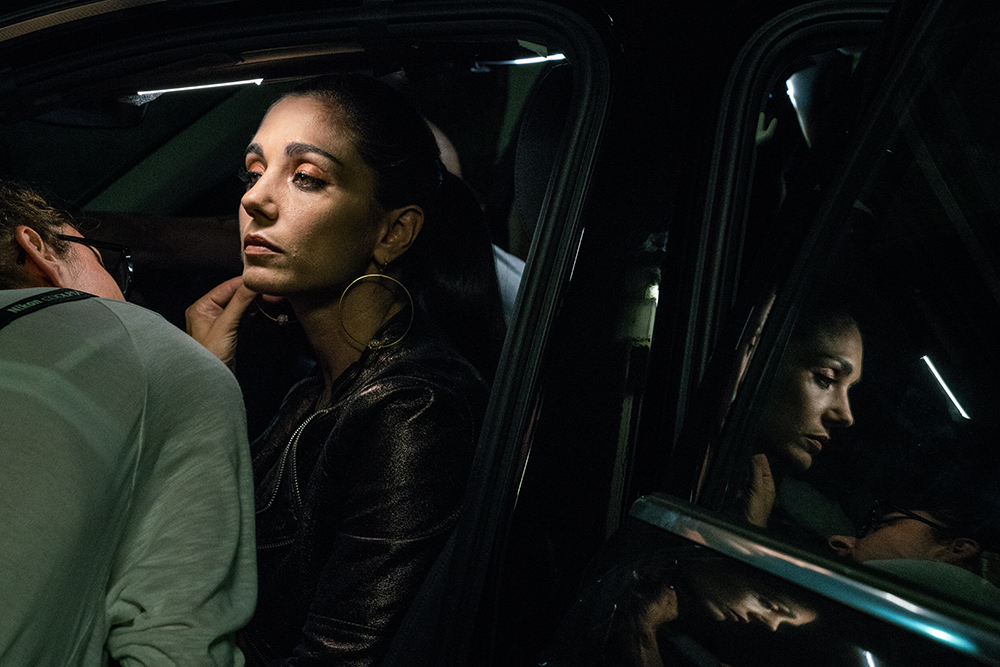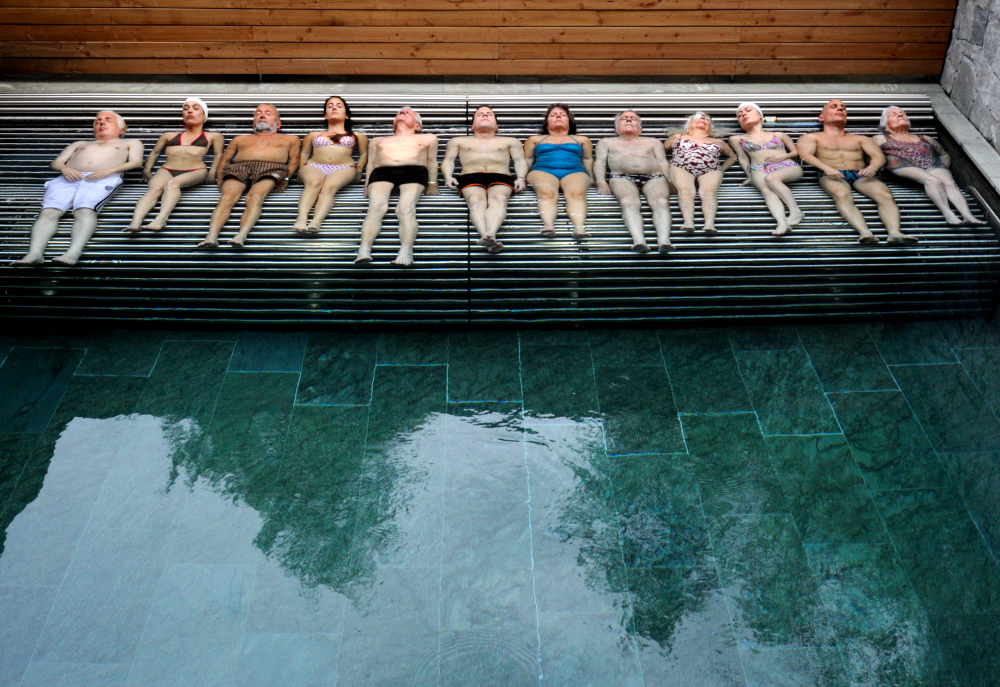by Azzurra Immediato
_
Set photography: a parallel universe of cinematography with which it intersects, subverting scientific axioms and generating a sort of galaxy that imprints multiple traces of what will remain in the collective memory for years to come. An extraordinary vision emerges, an otherwise submerged world which, through the tireless work of set photographers, becomes a precious archive, not only of cinematographic history but also of photography. The gaze of the set photographer is astonishing, it offers, to those lucky enough to see such shots, a unique, unrepeatable scenario, the here and now of something that, on the contrary, can be watched over and over: the movie. The set photographer is, therefore, a second demiurge, he creates a different life.
And Gianni Fiorito is the name par excellence of Italian set photography and beyond, who was able to create a collective imagination that has become the very essence of a certain author’s cinematography. Neapolitan, with a career started with reportages, in a Naples that, in the ’80s, had so many wonderful things to tell, linked to the ever-changing artistic scene, but also terrible ones, linked to the facts of Camorra, to the trials, to what the road left in the eyes and lenses of photojournalists. Much of this story in pictures by Gianni Fiorito is preserved, as a sign of history, in the volume Come eravamo. Napoli dal terremoto alla città spettacolo [The way we were. Naples from the earthquake to the city show], published by Silvana Editoriale and linked to the solo exhibition of 2004, in the rooms of the Maschio Angioino in Naples.
For the new issue of Photolux Magazine which focuses on the relationship between Cinema & Photography, I had the pleasure of talking to Gianni Fiorito and asking him some questions in order to better understand what happens on a set but, above all, what is the role of the set photographer, especially for who, like him, had built their career with an eye on the kaleidoscopic complexities of our world.

Cinema and Photography: what is the link between the two languages that is impossible for the spectators to see?
The main link is the story, that is the story that is both in the film and in the set photo. But there is also a simpler link which is the use of a technical tool, the lens, necessary to capture images.
However, the analogies end here, the cinematographic language is made up of movements, both of machines and of men, words, music. Photography freezes a moment, it needs an extreme synthesis to tell the same story, to convey the same emotions.
Your career started with photojournalism, the one that told of the guts of Naples, but also of its successes, its many stories, magmatic and fluctuating. A lens that crystallized the deaths of Camorra or the great events of an intricate Naples, in the early 1980s; how did you come to the passage where the story of reality was translated into a story of cinematographic fiction?
In my early years as a professional photographer, I divided myself between a scrupulous account of the social life of the city and the documentation of the city’s artistic ferment of the early 1980s, in particular the visual arts, music and theatre. When, twenty years later, at the dawn of the new millennium, the changed national publishing scene led to the crisis of the major newspapers and the gradual disappearance of in-depth reportage, I looked around in search of a different professional approach and that early experience was fundamental to get closer to the cinema, to the set, to a complex microcosm where many stories, real and fictional, take place, with innumerable stories.
Add to this that I have always been a voracious fan of films – even as a teenager I went to the cinema four or five days a week – and Bob’s your uncle.

What does set photography ask a photographer? And what did you ask Gianni Fiorito?
Concentration and synthesis skills. The latter was already refined by twenty years of journalistic work, when an event had to be told in a single shot to be reproduced on the page of a newspaper with and attract the reader’s eye, his attention, giving him all the elements to understand a story in an instant. Concentration is necessary in order to observe the many stories that simultaneously unfold on the set and around it, both fictional – the scene of the film, its protagonists – and real – the work of the technicians and the director, his relationship with the actors and other professionals of the troupe. The set photographer is physically inside this whole world, but only through concentration, his abstracting can, simultaneously and figuratively, stand three meters back and observe everything, ready to jump from one story to another and photograph it.
Does the perfect shot exist, the one that tells the main cinematography of a work, the wishes of the director, the screenwriter and which must necessarily be contained in a single, essential, shot?
Of course, it is what I call the necessary synthesis, which is obtained when with a single photograph you can tell an entire story. In the case of the still photo, a cinematic story. Since reading the script, my attention is focused on some scenes that are central to the story, then, during the shooting, following the staging of the director and the acting of the actors it becomes clearer which are the most important aspects to highlight in the photographs.

Over the years many of your well-known photographs and other shots stolen from the set have taken the form of an exhibition. A sort of “Chinese box”, a mise en abyme of something fake, narrated by photographic truth, ready to become cinematic fiction … and so on. What does an exhibition in which set photography becomes the protagonist, reaches the centre of the “actor’s stage” and shifts, for a few moments, the attention from the film plot really tell us? And where do all the shots from a set end up?
Let me start from the end of your question: of the enormous amount of work carried out on the set by the set photographer, the production, through its promotion offices, will use a limited amount of images, between 10/30 photos for a movie, around 100 for a TV series. This data prompted me from the beginning of my experience to try and enhance the photographic work, always promoting the cinematographic work but also giving to my work as a set photographer, the character of a unique work. The creation of books and photographic exhibitions allows me to highlight the complexity of my story, the entire set becomes a single story made up of men, landscapes, expectations, where reality meets imagination and fantasy flows into reality.
What is left, today, in the language of the photography of the Neapolitan photojournalist Gianni Fiorito and what would you give to the young man of that time, who looked at the brutality of reality without fear?
I would have a lot to give: my approach to the set remains that of a photojournalist ready to catch a gesture, an expression. My position on the set changes continuously, sometimes I’m in the centre of the scene, others more hidden away, in search of the invisibility that allows you to seize a moment without conditioning it. To that young photojournalist, I would recommend a greater willingness to experiment, to “make his images spectacular.”

“Photography freezes a moment in time, it needs an extreme synthesis to tell the same story, to convey the same emotions” says Fiorito who descends into the ideas following an emotional path: “From the moment I read the screenplay, my attention is focused on some scenes that are central to the story” and from this process comes a vision, what Gianni Fiorito calls “necessary synthesis” but which, nevertheless, knows how to wear an aura full of unfathomable pathos.
Stage photography probably represents the surreal echo of the cinematic story and observing Gianni Fiorito’s shots infinite and personal synapses will come in the mind of every reader, in favor of the real construction of a memory based on scenic fiction. Fiorito reads and interprets the ideas of a director and a screenwriter, translates this initial story into an ideal image and, with an almost magical act, searches for that perfect image, the unrepeatable instant that embodies the true essence of the film, and finds it. Certainly, experience is pivotal since Gianni Fiorito’s approach on the set “remains that of a photojournalist careful to capture a gesture, an expression” and this is how his vision overlaps with ours, giving life to the infinite archive of a utopian and bewitching dimension.
All images: © Gianni Fiorito
November 10, 2020




